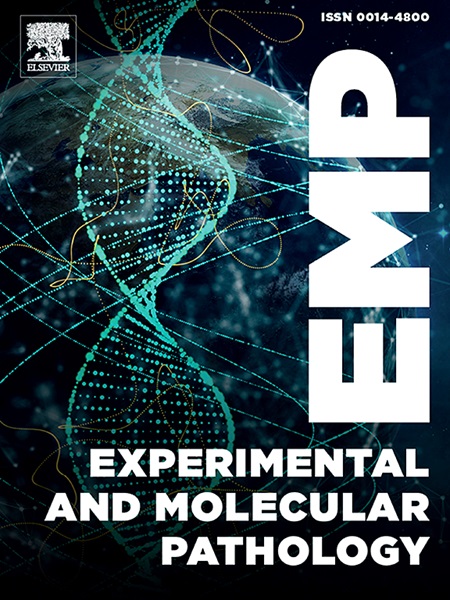In Silico分析揭示了DPP9的rs2109069是COVID-19严重程度和炎症症状风险的潜在催化剂
IF 3.7
4区 医学
Q2 PATHOLOGY
引用次数: 0
摘要
在2019冠状病毒病大流行期间,由SARS-CoV-2引起的病毒性疾病通过呼吸道飞沫传播,导致全球大流行,症状从轻微到严重不等。病理性炎症是一个关键问题,但过度激活炎症反应背后的遗传机制尚不清楚。为了揭示发病机制的遗传和调控基础,我们首先通过不同严重程度的COVID-19全现象关联研究(PWAS)探索了可能的遗传机制。PWAS是一种识别多效性风险变异的遗传研究方法,有助于阐明不同性状的潜在生理机制。方法采用PWAS方法将多种临床症状与变异联系起来。我们在二肽基肽酶9 (DPP9)中发现了一种常见的变异rs2109069,它与COVID-19引发严重疾病的风险比升高有关。有趣的是,rs2109069的代理基因已被确定为间质性肺疾病(ILD)和特发性肺纤维化(IPF)的易感位点。因此,我们检查了DPP9在选定器官中的表达模式,包括肺、血管和皮肤。结果计算机分析显示,covid -19诱导的炎症与ILD和IPF之间存在保守的驱动因子激活。多组学分析进一步证实了DPP9与COVID-19异常炎症反应的相关性。最后,基因同源性分析推断DPP9在抑制炎症小体激活方面具有潜在的调节作用,这表明DPP9缺乏可能会加剧部分COVID-19患者的炎症。结论我们的研究结果表明,严重的COVID-19炎症反应与炎症性肺部疾病具有相同的遗传风险位点,有助于阐明严重的COVID-19炎症的潜在生理机制。此外,免疫敏感性的个体差异可能导致患者多器官炎症反应的不同。DPP9的rs2109069可能是预测特定COVID-19症状和严重程度风险的遗传标记。本文章由计算机程序翻译,如有差异,请以英文原文为准。
In Silico analysis unveils rs2109069 of DPP9 as a potential catalyst for COVID-19 severity and risk of inflammatory symptoms
Background
During the COVID-19 pandemic, the viral illness caused by SARS-CoV-2 spread through respiratory droplets, resulting in a global pandemic with a range of symptoms from mild to severe. Pathological inflammation posed a critical issue, yet the genetic mechanisms behind the excessive activation of inflammatory responses remained unclear. To uncover the genetic and regulatory basis of the pathogenesis, we first explored possible genetic mechanisms from phenome-wide association studies (PWAS) with different severity levels of COVID-19. PWAS is a genetic research approach that identifies pleiotropic risk variants that contribute to elucidating potential physiological mechanisms from different traits.
Methods
We used the PWAS approach to link the multiple clinical symptoms to the variants. We discovered a common variant, rs2109069, in dipeptidyl peptidase 9 (DPP9), which relates to the elevated odds ratio of developing severe illness from COVID-19. Interestingly, the proxy of rs2109069 has been identified as the susceptible locus of interstitial lung disease (ILD) and idiopathic pulmonary fibrosis (IPF). We thus examined the DPP9 expression patterns in selected organs, including the lungs, blood vessels, and skin.
Results
In silico analysis revealed conserved driver activation between COVID-19-induced inflammation and the association with ILD and IPF. Multi-omics analysis further verified the association of DPP9 with abnormal inflammatory responses in COVID-19. Lastly, gene homology analysis inferred a potential regulatory role of DPP9 in inhibiting inflammasome activation, which suggests that DPP9 deficiency may exacerbate inflammation observed in some COVID-19 patients.
Conclusions
Our in silico findings reveal that severe COVID-19 inflammatory responses and inflammatory lung diseases share the same genetic risk loci, helping to elucidate the underlying physiological mechanisms of severe COVID-19 inflammation. Additionally, the individual differences in immune sensitivity may contribute to the varying multi-organ inflammatory effects among patients. The rs2109069 of DPP9 could be a genetic marker to predict the risk of specific COVID-19 symptoms and severity.
求助全文
通过发布文献求助,成功后即可免费获取论文全文。
去求助
来源期刊
CiteScore
8.90
自引率
0.00%
发文量
78
审稿时长
11.5 weeks
期刊介绍:
Under new editorial leadership, Experimental and Molecular Pathology presents original articles on disease processes in relation to structural and biochemical alterations in mammalian tissues and fluids and on the application of newer techniques of molecular biology to problems of pathology in humans and other animals. The journal also publishes selected interpretive synthesis reviews by bench level investigators working at the "cutting edge" of contemporary research in pathology. In addition, special thematic issues present original research reports that unravel some of Nature''s most jealously guarded secrets on the pathologic basis of disease.
Research Areas include: Stem cells; Neoangiogenesis; Molecular diagnostics; Polymerase chain reaction; In situ hybridization; DNA sequencing; Cell receptors; Carcinogenesis; Pathobiology of neoplasia; Complex infectious diseases; Transplantation; Cytokines; Flow cytomeric analysis; Inflammation; Cellular injury; Immunology and hypersensitivity; Athersclerosis.

 求助内容:
求助内容: 应助结果提醒方式:
应助结果提醒方式:


